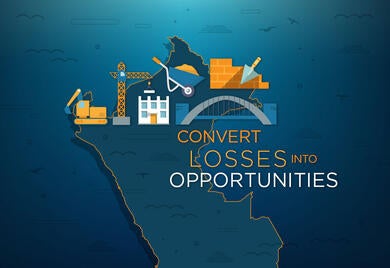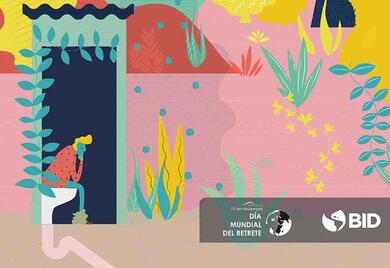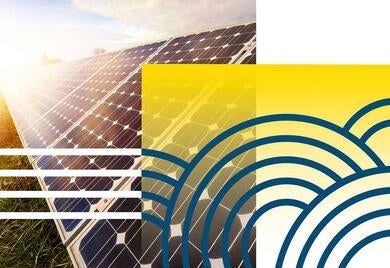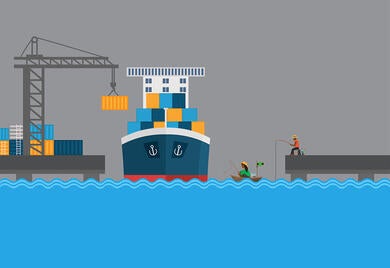
How sustainable infrastructure can decide Peru’s future
Last March, Peru experienced extreme weather conditions in the north of the country. This resulted in numerous physical, economic and human losses with costs associated at over US$3 billion, or 0.5% of GDP. Planning for reconstruction, the country found itself at a crossroads: it could focus solely on meeting immediate construction needs or rebuild with a long-term vision. The latter option, to adapt the new infrastructure to the uncertainty of weather conditions, represents an opportunity to incorporate sustainability in highways, bridges, water distribution and management systems, as well as to leverage public-private partnerships and rebuild Peru’s economy to compete in the global market. The government of Pedro Pablo Kuczysnki has launched a reconstruction plan called “Reconstruction with Changes” which has two phases. The first seeks to invest up to US$3 million in immediate reconstruction and resettlement. The second, projected to last five years, focuses on the development of modern, climate-resilient public works that represent an additional investment of US$6 billion. A private sector opportunity A large part of infrastructure losses is absorbed by private markets, and for this reason the private sector has a lot to gain from reconstruction. For example, a new highway can allow products to reach their markets more quickly, lowering the cost of doing business for companies. The private sector not only benefits from reconstruction. It could also be part of its development. Estimates from the World Economic Forum suggest that for every dollar of public capital that is mobilized to close the infrastructure gap, five dollars of private capital should be mobilized. However, financing alone is not enough. Key tools for reconstruction IDB Invest (formerly known as Inter-American Investment Corporation), the IDB Group’s private sector arm, has experiences in technical assistance that can serve as a reference for Peru. In Mexico’s Port of Manzanillo, we found ways to adapt the design of the port to unpredictable weather conditions. This included ensuring reforestation and measuring the port’s carbon emissions. We made sure that the terminal operators have the tools and training necessary to replicate the environmental assessments every year. We also use the Envision methodology, developed by Harvard University’s Zofnass Program for Sustainable Infrastructure and the Sustainable Infrastructure Institute. The methodology focuses on quality of life, leadership, resource allocation, the natural world and climate, and risk. The tool has helped our clients measure sustainability, particularly during project planning and design phases. Environmental and social safeguards promote minimum quality in infrastructure investments. In June 2014, during the review of a loan to a local cement plant, our environmental models predicted atypical rains in Asunción, Paraguay. Our environmental specialists needed a contingency plan. When flooding occurred, the plant mitigated damage although there were some construction delays. The project’s sponsor recognized the importance of the environmental safeguard measures and invested in additional water studies, new internal routes with barriers and protected storage facilities. [clickToTweet tweet="For every dollar of public capital in #infrastructure, US$5 of private capital should be mobilized" quote="For every dollar of public capital that is mobilized in infrastructure, five dollars of private capital should be mobilized" theme="style1"] Corporate governance safeguards and attention to integrity also strengthen infrastructure sustainability. Although Latin America is a middle income region, two-thirds of its countries fall in the bottom half of Transparency International’s “corruption perception index.” According to this organization, 26% of Peru’s population has been the victim of corruption. IDB Invest maintains the highest standards of integrity, and we are confident that with our support for the RCC we will reduce this rate. Finally, investments in sustainable infrastructure can attract institutional investors. Investing in socially and environmentally responsible companies is increasingly considered a fiduciary responsibility and a means for increasing the value of company assets over the long term. We have witnessed the interest of such investors when we presented sustainable and bankable investments. The Reventazón hydroelectric dam in Costa Rica and the Campo Palomas and Colonia Arias wind farms in Uruguay have been pioneer projects in attracting financing from local institutional investors. In Peru, we seek to leverage local money and our capacity to advise public-private partnerships to attract more local stakeholders. This is a critical moment, but Peru is well positioned to convert its losses into opportunities. Investments in sustainable infrastructure are the only guarantee for building a more inclusive, less vulnerable, and more competitive future in the 21st century. Subscribe to receive more content like this! [mc4wp_form]

How can we boost sustainable infrastructure investments?
Evidence is mounting that through the right mix of policies and incentives the world can significantly reduce climate risks while boosting growth. Last month, the Organisation for Economic Co-operation and Development (OECD) said that action on climate change can generate inclusive economic growth over both the short and long term. These policies can increase GDP by up to 2.8% on average across the G20 countries in 2050. The question is, how can we capitalize on these opportunities while reducing climate risk? We believe that the answer is joining forces from governments, multilateral development banks and investors to increase investments in sustainable infrastructure.

Latin America needs more broadband to capitalize on the data explosion
There are many stories about the origins of chess. To me, the most colorful is about a king in India who was given a new game consisting of two armies and 64 squares, to overcome the loss of a son in the battlefield. The king was so delighted with this new game that he offered to give the inventor anything he wished for as compensation: “Give me one grain of rice for the first square, two grains for the second square, four grains for the third square, and so on for each of the squares of the game board,” said the inventor.

Mobilizing the private sector to ensure access to water and sanitation for all
Sunday November 19th, 2017 will be Toilet Day. Why would we need a Toilet Day?! It is not a celebration day; as per the United Nations, “World Toilet Day is about taking action to reach the 2.4 billion people living without a toilet.” In Latin America and the Caribbean, access to sanitation is one of our greatest challenges: only 22% of the population has access to safely managed sanitation, and 20 million practice open defecation. So how do we make this day meaningful? We should put it in a wider context, as it obviously goes beyond raising awareness. Indeed, the Sustainable Development Goals (SDGs) propose to transform the world. Goal six ambitions to “ensure access to water and sanitation for all” includes a clear target: By 2030, achieve access to adequate and equitable sanitation and hygiene for all and end open defecation, paying special attention to the needs of women and girls and those in vulnerable situations. A $15 billion market There is a case for the private sector in this target: toilets play a crucial role in creating a strong economy, as well as improving health and protecting people’s safety and dignity. Given the magnitude of the resources needed and the public resources constraints, it is essential to mobilize the private sector for: the funding of the investments, the construction, and the efficiency improvement in the operation of the infrastructure. In sanitation, there are near 15 million households without access to improved sanitation in Latin America and the Caribbean, which represents a market and potential revenue of up to $15 billion only for construction of sanitation infrastructure. While in pit or septic tank emptying and wastewater/sludge collection services, the market potentially reached over a billion dollars per year across the region, according to an IDB study. This also means the potential creation of thousands of jobs, provided with the help of the private sector. A drop of financial innovation For this we need a clear risk-reward framework, recognizing that “financial sustainability can be achieved through a combination of rates, tariffs and subsidies”. Also, it is important to state that — under adequate models — the private sector can supplement the public-sector approaches to reach lower income population, which is the most affected by lack of service coverage. [clickToTweet tweet="In #sanitation, there is a potential revenue of up to $15 billion in #LatinAmerica & #Caribbean" quote="In sanitation, there is a potential revenue of up to $15 billion in Latin America and the Caribbean" theme="style1"] To better serve the base of the pyramid, the region needs to promote blend participation from public, private and financial sectors for water and sanitation services. For example, SOIL, in Haiti, shows an innovative sanitation business model for lower-income households. It is a service to collect the waste from ecological toilets to treatment plants, where it is sold for agricultural purposes. This sustainable model covers the entire sanitation chain and after a few years it has already served over 2,000 people. With only 12 years left to accomplish the SDGs and the vast amount of resources required, we should recognize the need for an integral approach to water and sanitation services. Today, those lacking these network services are those that pay the highest price for alternative arrangements. However, with coordination between the public and the private sector we could develop products to better serve them. Development banks, like the IDB Group, engaging the private sector through IDB Invest and leveraging its public-sector presence, have an important role to play in promoting those synergies. Subscribe to receive more content like this! [mc4wp_form]

The way to build the future is to invest in it
The world is evolving at exponential speeds. Technology is contributing to a future marked by major social and economic improvements. This is especially true in Latin America and the Caribbean. Mobile subscribers in the region have increased 800% in the last five years. In 2017, financial technology (fintech) companies transacted more than US$90 billion in transactions in the region, an amount that surpasses Panama’s gross domestic product (GDP). And the region already leads the world in clean energy. Private sector innovation and competition have led to much of these technological advances, but development challenges remain. The region’s productivity lags its East Asian peers. Financing gaps, such as infrastructure, amount to billions of dollars or over 2% of the region’s GDP, while women-led businesses are still less likely to access financing than their male counterparts. The speeds, flexibility and power of technology have their limits. Our clients in the region’s private sector have ambitious goals, and it will take a range of solutions to achieve them. Designing for trust and client-focus For example, AirBnB, a hotel retailer, has grown from zero to 24 million annual guests in less than a decade. AirBnB does rely on technological platforms to unite lodging supply with demand, but it is the company’s ability to foster trust that gave it market leadership. This means fostering trust not only in the company to match people and process payments but also fostering trust among complete strangers who share their homes with one another. AirBnb, like Netflix, iTunes and so many others, remind us that technology alone is not the real disruptor. Designing for trust and the client experience is much bigger. Staying relevant while building a better future The digital disruption leaves no room for complacency. In addition to upending the hotel industry, it has taken over taxi and retail services highlighting that the quest to stay relevant is more difficult than ever. These changes, coupled with cash strapped governments and geopolitical shifts, put pressure on development banks to turn the billions on their balance sheets into trillions of development finance. To compete in today’s world and achieve our collective development goals, we must find ways to solve tomorrow’s challenges. A client experience defined by process agility, product flexibility and a sense of trust will allow development banks to stay relevant in changing times. Staying relevant includes more equity and quasi-equity, such as mezzanine and subordinated debt, to grow companies and allow them to create jobs. It includes engaging institutional investors through products like B-Bonds and demonstrating that their investments in emerging markets can perhaps outperform their developed market comfort zone. Staying relevant includes offering more local currency so that borrowers can repay in the currency they are generating cash flow. We also work in a world of liquidity where cash is no longer king. Providing advisory and knowledge to our clients will be what adds value and defines our development impact. These are some of the ways development banks can better tailor client experiences, reduce risks and allow clients to focus on stimulating development. Today, we are launching the most consequential makeover in our history. We are revamping our vision, strategy, products, sectors and culture under the new brand IDB Invest. This is about our commitment to take the best of what works. Our synergies with IDB coupled with product flexibility and process agility incorporate the best of the public and private sectors. Our transformation may be facilitated by technology, but it will be driven by a quest to put clients at the center and earn their trust and business in return. This will ensure the development impact for all our stakeholders. Subscribe to receive more content like this! [mc4wp_form]

Making social investments count
When someone searches the word “sustainability” online, images of wind farms, trees, and waterways dominate the results. What is often missing from these photographs are people. It remains a challenge to break the habit of equating sustainability just with the environment. Sustainability, at its core, is something that should conjure not just these images but illustrations depicting people and the benefits of a positive healthy community. The private sector, in particular, should desire sustainable communities since this can often translate into better economic performance. According a study conducted by Deutsche Asset Management and the University of Hamburg, there is a positive correlation between good environmental, social and governmental practices and improved corporate financial performance. In other words, it literally pays to incorporate sustainability at the core of one’s primary business. An example of this is the Kingston Freeport Terminal Limited (KFTL) sustainable program at the Kingston harbor, in Jamaica. After winning the 30-year concession to operate the Kingston Container Terminal, KFTL saw an immediate need to seek out partners to become the catalysts for development in the harbor. Making room for sustainable infrastructure The first field visits to KFTL were challenging. I arrived at Greenwich, one of the largest fishing beaches in the harbor, to be immediately struck by the complexity of its location. Situated between the harbor and the state oil refinery on a slim piece of land, I wondered how these two could coexist. The visible conditions were extremely poor: no basic infrastructure and a landscape dotted with makeshift wooden shacks. Despite this, there was a real community there; fisherfolk (as they are called in Jamaica), who for several generations have made their livelihood from fishing these waters, have adapted to an extremely challenging environment. They are the largest —more than 4,000— and most economically vulnerable stakeholder. [clickToTweet tweet="Private sector should desire sustainable communities since they improve economic performance" quote="Private sector should desire sustainable communities since they improve economic performance" theme="style1"] As we began our conversations with the fisherfolk the tension was clear. The main concern was about the impact in their business, since previous experiences negatively affected their fish catch for more than a year. To define a social investment strategy and successfully structure the deal, IDB Invest (formerly known as Inter-American Investment Corporation) began working with KFTL. The purpose was to help the company to develop a long-term sustainability approach to ensure that investments produce benefits not only to private sector companies working with us but also to society. Coming to a sustainable agreement KFTL concession allows the company to modernize the harbor and to conduct dredging operations to receive larger Panamax vessels, which are designed to pass through the Panama Canal. These operations will increase employment opportunities for the surrounding communities, and help port operators engage with other stakeholders to ensure long-term sustainability for all harbor users. However, the creation of a long-term sustainability program was also a main objective for the company. This will be paramount to enhance relationships among port stakeholders, and invest in improving fisherfolk conditions. To increase social inclusion and incentivize an open dialogue, we recommended the creation of a committee with the fisherfolk fishing beach representatives, the Jamaican Port Authority, and KFTL staff. The committee has defined three main activities to revitalize the harbor: 1) provide livelihood support during dredging activities; 2) conduct solid waste cleanup of fish nurseries within the harbor; and 3) develop a fish sanctuary and artificial reef outside the harbor. These programs are still in their planning phases. However, their investments will provide long-lasting benefits to a community that has experienced declining incomes and economic vulnerability for years. On the business side, the 830 government workers from the port were employed by KFTL, and as container traffic increases additional labor growth is expected. Moreover, since the handover an additional 40 staff have been hired in various positions throughout the company. Ultimately, KFTL commitment will help shaping what it means to be a sustainable company while simultaneously providing a tangible improvement to an extremely vulnerable population. This is one clear example of how the private sector can leverage its resources to create economic benefits not only for itself, but also broad societal benefits for key stakeholders. Subscribe to receive more content like this! [mc4wp_form]